
Research on the effects of Eruption guidance appliances (EGA)
Research in Finland by Dr. Katri Keski-Nisula, PhD
- 3 year treatment with EGA
- Follow-up study on effects and long-term stability for Class II patients
Research in Norway by Dr. Rita Myrlund, PhD student
- One year treatment with LM-Activator™
- Follow-up study on the stability of treatment outcomes
Research summary / White Paper
We have gathered the main findings published from the research made in Finland of the effects and benefits of orthodontic treatment in early mixed dentition with Eruption Guidance to a white paper.
With the help of this summary we aim to offer easy and concise access to the research results for dentists.
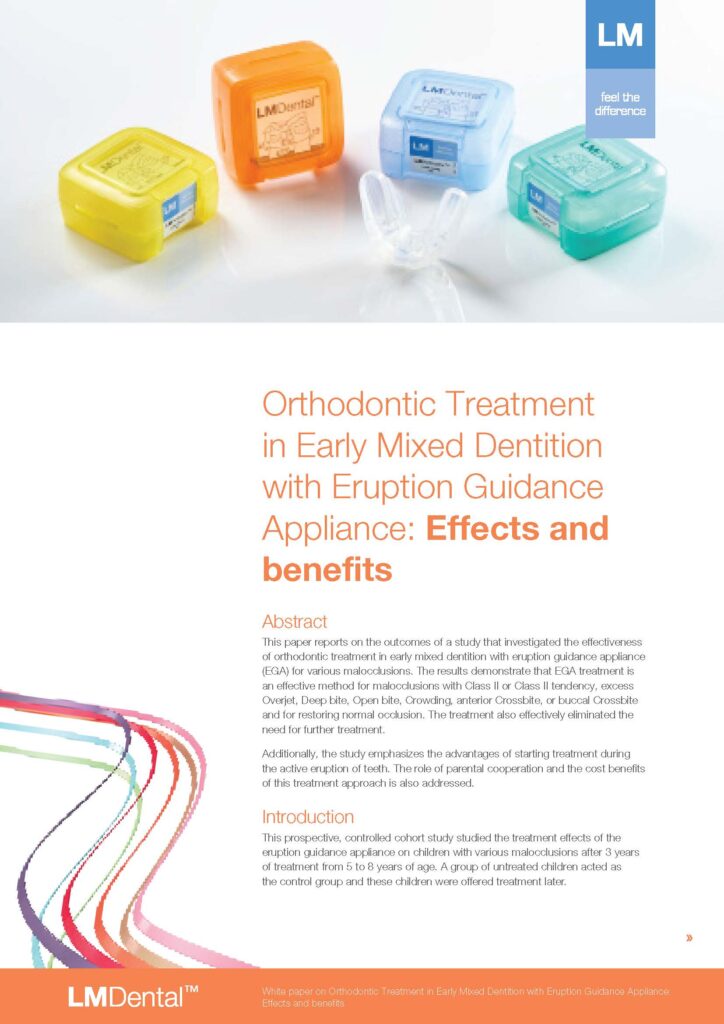
LM-Activator™ research at Turku University, Finland
“When I saw the results of LM-Activator™, I was surprised. I recommend my colleagues to try LM-Activator™ and see the results themselves.”
Professor Juha Varrela,
University of Turku, Finland
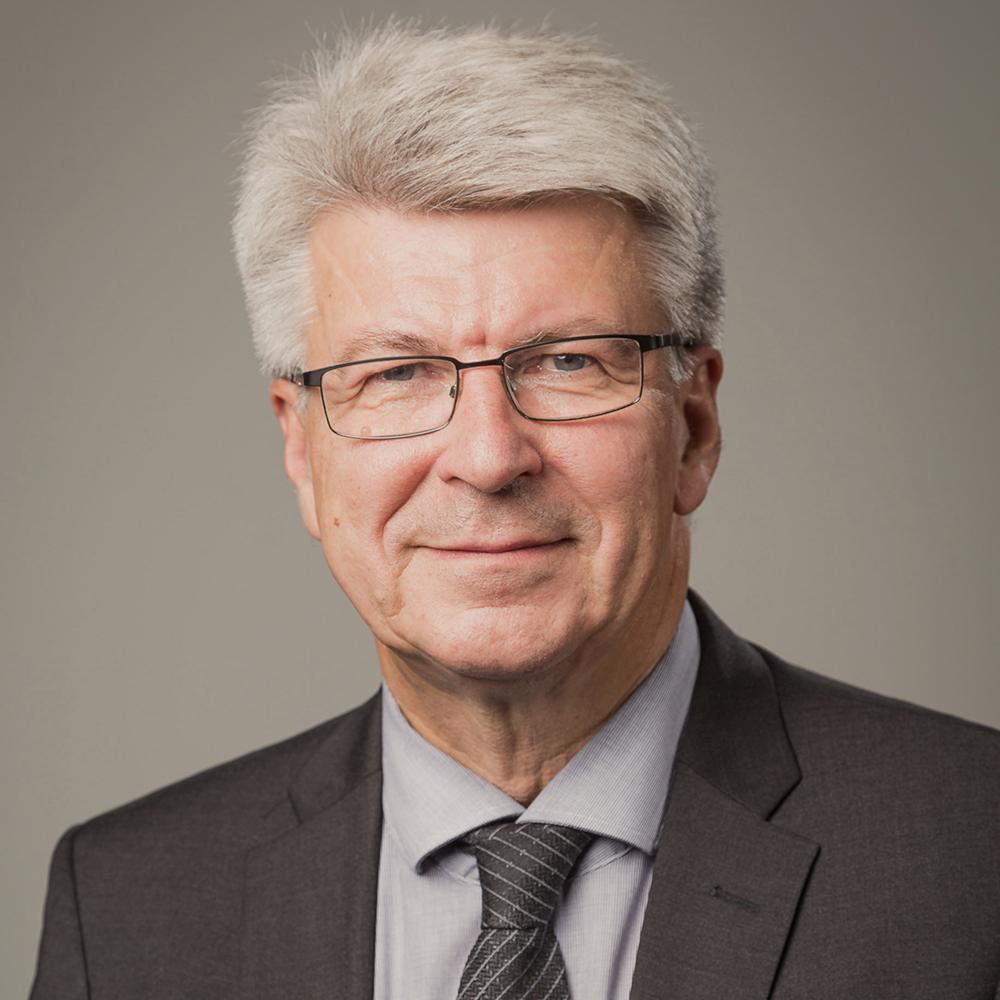
The research results speak for themselves. LM-Activator™ is an effective method for treating malocclusions in the mixed dentition with stable results.
A prospective, controlled cohort study conducted in Finland in the 1990s studied the treatment effects of the eruption guidance appliance after 3 years of treatment of children from 5 to 8 years of age. A group of untreated children acted as control group and these children were treated later.
The results show a clinically significant correction of molar relationship, overjet, overbite, incisor alignment, and growth enhancement of the mandible. The authors conclude that the results indicate that orthodontic intervention with the eruption guidance appliance in the early mixed dentition is effective for treating malocclusions with Class II or Class II tendency, excess overjet, deep bite, open bite, crowding, anterior cross-bite, or buccal crossbite. In the middle of the mixed dentition stage, there was little – if any – need for treatment in the treatment group compared to the control group, where there the frequencies of malocclusions were more common.
You can read more about the study and the findings here:
K. Keski-Nisula, R. Hernesniemi, M. Heiskanen, L. Keski-Nisula, J. Varrela: Orthodontic intervention in the early mixed dentition: A prospective, controlled study on the effects of the eruption guidance appliance. American Journal of Orthodontics and Dentofacial Orthopedics: 2008:133:2: 254-260. doi.org/10.1016/j.ajodo.2006.05.039
An advantage of the eruption guidance appliance is that it not only guides the eruption of the teeth but also simultaneously acts on the transversal, sagittal, and vertical relationships of both dental arches.
Keski-Nisula, K., et al. J. Orthodontic intervention in the early mixed dentition: A prospective, controlled study on the effects of the eruption guidance appliance. AM J of Orthodontics and Dentofacial Orthopedics, 2008:133(2), 254-260. https://doi.org/10.1016/j.ajodo.2006.05.039
Keski-Nisula K; Keski-Nisula L; Salo H; Voipio K, Varrela J. Dentofacial Changes after Orthodontic Intervention with Eruption Guidance in the Early Mixed Dentition. Angle Orthod 2008;78:324-331. https://doi.org/10.2319/012607-37.1
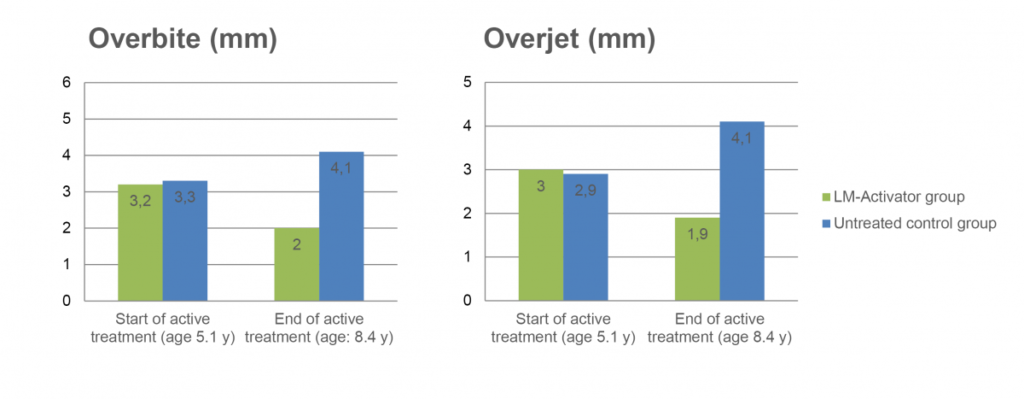
Read the Research summary in pdf file >
Follow-up article on LM-Activator™ research at Turku University, Finland
In 2019 a follow-up article was published analyzing the effects and long-term stability for the same patients in the treatment group and in the control group, in which the patients received treatment later.
According to the authors, the aim was to analyze dentoskeletal effects and long-term stability of Class II treatments carried out with the eruption guidance appliance in early mixed dentition. The result of the analysis of stability show that the treatment results remain largely stable in the early permanent dentition. As a result of the EGA treatment, the sagittal relationship was corrected from Class II to Class I in 86% of the cases during active treatment, and it even showed further improvements after the treatment so that at the age of 16.7 years, 98% of the treated children had a Class I relationship. These patients all had Class II relationship at the beginning of the early mixed dentition phase.
As a result of the treatment, the mandible of the treated children grew 5 mm more compared to patient in the control group during the period of early mixed dentition. The higher mandibular growth rate seemed to be a major factor contributing to the correction of Class II to Class I molar relationship in the treatment group. There was also no indication that enhanced growth of the mandible would have been only temporary. This would indicate that the early EGA treatment in addition to correcting the occlusion also guided the skeletal development into a more normal Class I development path.
None of the children treated in early mixed dentition needed a second treatment phase.
K. Keski-Nisula, L. Keski-Nisula, J. Varrela: Class II treatment in early mixed dentition with eruption guidance appliance: effects and long-term stability. European Journal of Orthodontics: 2020:42:2:151-156. https://doi.org/10.1093/ejo/cjz092
As a result of the EGA treatment, the sagittal relationship was corrected from Class II to Class I in 86% of the cases during the active treatment, and it showed further improvement post-treatment. At the age of 16.7 years, 98% of the treatment children, who all had a Class II relationship at the onset of the early mixed dentition, had a Class I relationship.
Keski-Nisula K., et al. Class II treatment in early mixed dentition with the eruption guidance appliance: effects and long-term stability. European Journal of Orthodontics, 2020:42(2):151-156. https://doi.org/10.1093/ejo/cjz092
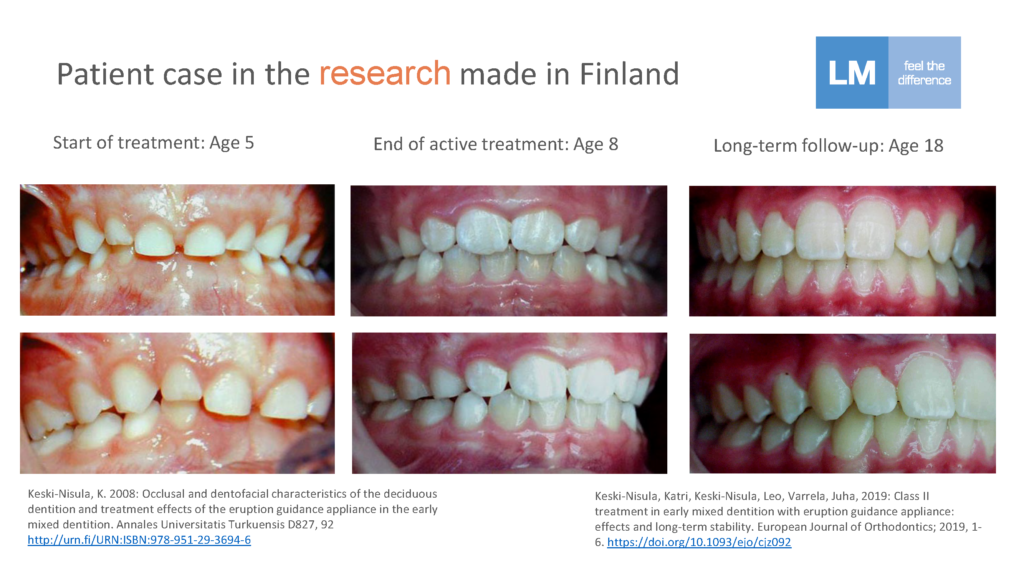
LM-Activator™ research at Tromsø University, Norway
Research shows that LM-Activator™ is effective in orthodontics of 7 – 8 year old children
An RCT-article from the University of Tromsø, Norway states that malocclusions may be corrected by orthodontic treatment with LM-Activator™ during the early mixed dentition. After one year of treatment with the silicone appliance significant improvements in Class II, overjet, overbite and crowding where achieved, according to the article published in the European Journal of Orthodontics.
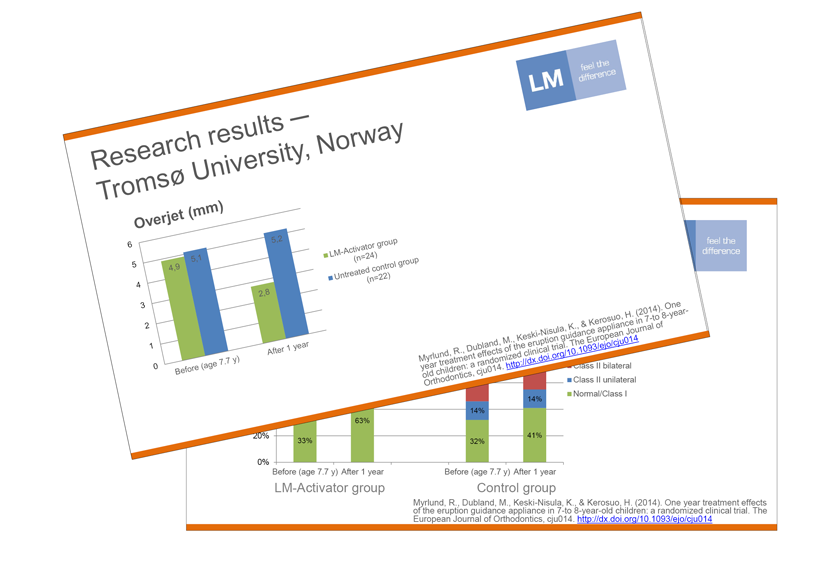
- Tromsø University LM-Activator™ reseach result summary
- You can also download and save the full article from here: One Year Treatment Effects of the Eruption Guidance…
R. Myrlund, M. Dubland, K. Keski-Nisula, H. Kerosuo: One year treatment effects of the eruption guidance appliance in 7- to 8-year-old children: a randomized clinical trial. European Journal of Orthodontics: 2015:37:2:128-134. https://doi.org/10.1093/ejo/cju014
Our results showed distinct improvements in overjet, overbite, sagittal molar relationship, and crowding in the treated subjects.
Myrlund R., et al. One year treatment effects of the eruption guidance appliance in 7- to 8-year -old children: a randomized clinical trial. European Journal of Orthodontics, 2015:37(2):128-134. https://doi.org/10.1093/ejo/cju014
A prospective follow-up study was conducted to investigate occlusal stability from early mixed to the permanent dentition in the children treated in the initial 1-year RCT-study. The children both in the initial treatment group and in the control group that was treated later were invited to attend a follow-up examination and an interview. According to the article published in the Angle Orthodontist in 2019, result show that early correction of increased overjet, overbite, and class II molar relation can be maintained and can also be effective in the permanent dentition, proved that the EGA (LM-Activator™) is worn regularly as retainer.
R. Myrlund, K. Keski-Nisula, H. Kerosuo: Stability of orthodontic treatment outcomes after 1-year treatment with the eruption guidance appliance in the early mixed dentition: A follow-up study. Angle Orthodontist, 2019:89:2:206-213
You can read the whole article here: https://doi.org/10.2319/041018-269.1
Myofunctional research shows a correlation between malocclusions and orofacial dysfunctions.
Grabowski, R., Kundt, G., & Stahl, F. (2007). Interrelation between occlusal findings and orofacial myofunctional status in primary and mixed dentition. Journal of Orofacial Orthopedics/Fortschritte der Kieferorthopädie, 68(6), 462-476. http://dx.doi.org/10.1007/s00056-007-0717-y



